The Milky Way galaxy, a seemingly vast and mysterious expanse, is our cosmic neighborhood. As you embark on this journey through the stars, you’ll find that the Milky Way has a rich and captivating history filled with remarkable celestial objects and intriguing phenomena. Get ready to unveil the secrets of this magnificent galaxy, as it’s much more than just a hazy band of light across the night sky.
You might be surprised that our Solar System, including Earth, is part of the Milky Way galaxy. The galaxy’s structure includes major and minor arms, with our Solar System nestled about 26,000 light-years away from the center. As you learn more about our position in the Milky Way, you’ll discover its numerous stars, celestial objects, and even its intriguing neighbors.
In a Nutshell:
- The Milky Way is our home galaxy, and it hosts our Solar System and countless celestial objects
- The galaxy’s structure consists of major and minor arms, with Earth located 26,000 light-years from the center
- Exploring the Milky Way reveals its fascinating history, diverse components, and intriguing phenomena
Recommended For You
Milky Way Formation and Structure
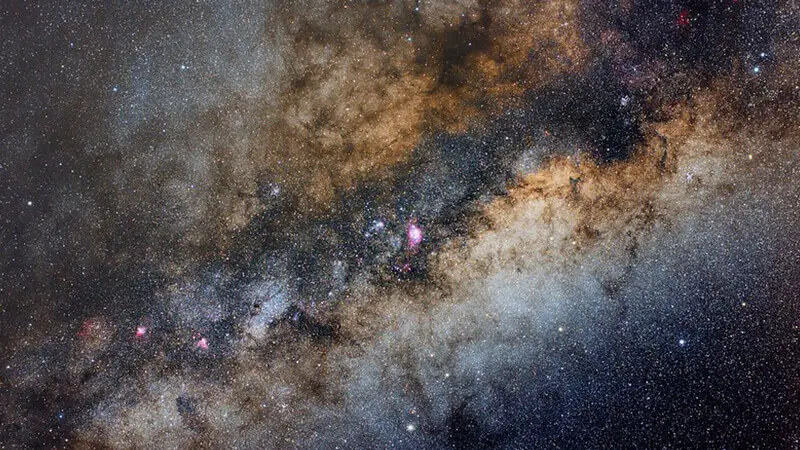
In your journey through the wonders of the universe, let’s explore the Milky Way galaxy. You’ll learn about its formation and structure, which are crucial for understanding our place in the cosmos.
Spiral Arms
Imagine the Milky Way’s stunning spiral structure, which involves two main spiral arms extending from the ends of a central bar. Picture these arms as winding patterns of billions of stars, gas, and dust. Remember that our Solar System is located within one of these spiral arms, approximately 26,000 light-years from the galactic center.
Central Bar
Now, take a mental trip to the central bar of the Milky Way. It’s a bar-shaped region packed with stars stretching across the galaxy’s core. While you’re there, remember to visualize it as the foundation around which the spiral arms are wrapped.
Central Bulge
Moving from the central bar, you’ll encounter the central bulge – a densely packed, spherical cluster of stars surrounding the galactic center. Consider it an older part of the Milky Way, containing ancient stars born billions of years ago.
Galactic Disk
Think of a flat, rotating disk surrounding the central bar and the bulge, and you’ll get a clearer picture of the Milky Way.
To help you visualize this galactic plane, here is a breakdown of the disk’s composition:
- Stars: These can be young, middle-aged, or old, and they may reside in the spiral arms or in between them.
- Gas: Mostly hydrogen and helium, providing the raw materials for new stars to form.
- Dust: Obscures our view of the galaxy, requiring radio and infrared telescopes to explore its structure.
Galactic Center
Finally, let’s delve into the heart of the Milky Way – the galactic core. It’s home to a fascinating region called Sagittarius A*, which is likely a supermassive black hole. Now, imagine this black hole’s incredible size, mystery, and power at the core of our galaxy, attracting and influencing everything around it.
Ready to dive deeper? Read my article:
As we continue our cosmic exploration, we’ll further unravel the mysteries of the Milky Way and its intriguing components. Who knows what exciting discoveries await us!
Age and Size of Milky Way Galaxy
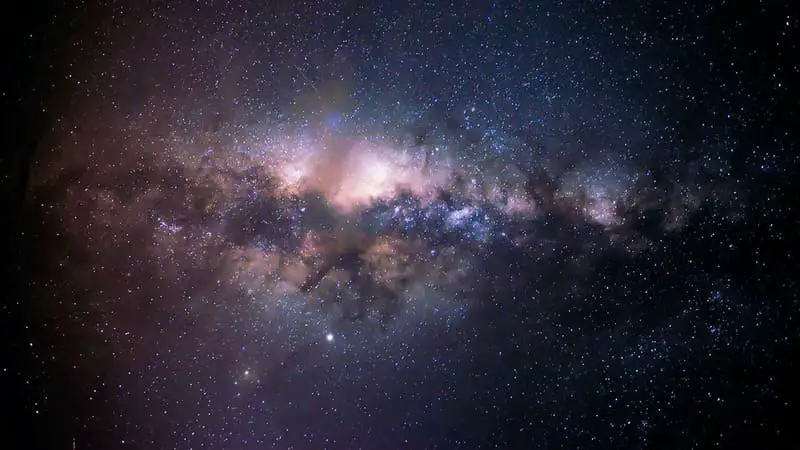
Age
The Milky Way is an ancient galaxy estimated to be 10 billion and 13.6 billion years old. You can imagine our cosmic neighborhood’s rich history as an amateur astronomer. Picture the countless stars that have formed and burned out during this extended period.
Diameter
Our galaxy has a diameter that spans approximately 100,000 light-years. To help visualize this enormous distance, imagine that you’re trying to travel across the Milky Way at the speed of light (about 186,282 miles per second). It would still take 100,000 years to cross from one end to the other!
Mass
The mass of the Milky Way galaxy can be mind-boggling. Weighing in at an estimated 1.5 trillion solar masses, our galactic home comprises stars, planets, gas, dust, and dark matter.
To give you a better idea of just how massive this is, consider the following:
- One solar mass equals the mass of our Sun
- There are about 300 billion individual stars in the Milky Way
- Each star can have multiple planets orbiting it
So, with all these massive numbers in mind, here are some fun facts about the Milky Way’s size and mass:
- Our galaxy has a diameter of about 100,000 light-years
- It contains between 100 and 400 billion stars
- The Milky Way’s mass is approximately 1.5 trillion times the mass of our Sun
Now that you better understand the Milky Way’s age, size, and mass, it’s time to explore more about this wondrous galaxy. Stay curious and keep looking up!
Our Position in the Milky Way

This section explores our place in the vast Milky Way galaxy. Understanding how the Sun, Earth, and the entire Solar System fit into the bigger picture can be fascinating. So let’s dive in!
Solar System
Your Solar System is a speck within the colossal expanse of the Milky Way. It consists of the Sun, eight planets, and numerous smaller celestial bodies like asteroids, comets, and moons. Did you know that your Solar System is in an outer spiral arm of the Milky Way galaxy? That’s right; while you might be a small part of this gigantic galaxy, you’re still an essential piece of the cosmic puzzle.
- Sun: The Sun, a massive burning ball of gas, keeps our Solar System together with its gravitational pull.
- Earth: Earth is your home, around 93 million miles from the Sun. It’s the third planet from it and a cozy little spot in the galaxy.
- Solar System: Located in the Orion Spur, your Solar System is just one of many, nestled within the spiraling arms of our galaxy.
Orion Spur
You now know the Solar System is in the Milky Way’s outer spiral arm. But what exactly is the Orion Spur? It’s a smaller structure branching off one of the more significant spiral arms, the Orion Arm. The Orion Spur is home to your Solar System and countless other stars, planets, and celestial bodies.
- Orion Arm: A larger arm containing the Orion Spur, serving as a significant building block of our galaxy.
- Orion Spur: The smaller branch where your Solar System resides, providing a unique perspective of the Milky Way’s grand structure.
So, as you gaze up into the night sky, remember you’re a part of something much more extensive and impressive. Try to spot the Milky Way and imagine your tiny—but essential—place within the universe’s grand scheme. With this newfound knowledge, you’re ready to explore more cosmic wonders. Let’s move on to the next exciting topic in our amateur astronomy journey!
Milky Way Stars and Celestial Objects

Number of Stars
In our spectacular Milky Way, there are around 100 billion stars, and one of them is our dazzling Sun. While gazing at the night sky, remember that all the stars we see belong to our galaxy.
Here are some facts about stars in the Milky Way:
- The majority of stars are smaller and cooler than our Sun.
- Some stars, called red giants, are much larger and cooler.
- Other stars are ultra-hot and massive, known as blue giants.
Ready to dive deeper? Read my article:
Black Holes
Although they might give you goosebumps just thinking about them, black holes play a crucial role in our galaxy. A typical black hole is formed from the core remnants of a massive star. But don’t worry! You won’t bump into them on your stargazing adventures. Our galaxy’s vip black hole, Sagittarius A*, is a supermassive black hole found at the center of the Milky Way. It has a mass equivalent to around 4 million times that of our Sun.
Nebulae
You might have seen some mysterious and colorful clouds floating in space images. These celestial masterpieces are called nebulae. They come in various shapes, sizes, and colors, but they all have something in common – they are the birthplaces of stars! When a massive cloud of gas and dust collapses due to gravity, it creates a new star. Here are three popular types of nebulae:
- Emission Nebulae: They glow with beautiful colors because of the high-energy radiation emitted from newborn stars.
- Reflection Nebulae: These celestial beauties reflect and scatter the light from nearby stars.
- Dark Nebulae: They appear like dark clouds, blocking the light from the background stars.
In the fascinating realm of Milky Way celestial objects, there are always discoveries to be made and new wonders to explore with your telescope. Now that you have explored some of the highlights of our galaxy’s stars and celestial objects, it’s time to dive deeper into the fantastic world of galaxies and their mysteries.
Observing the Milky Way
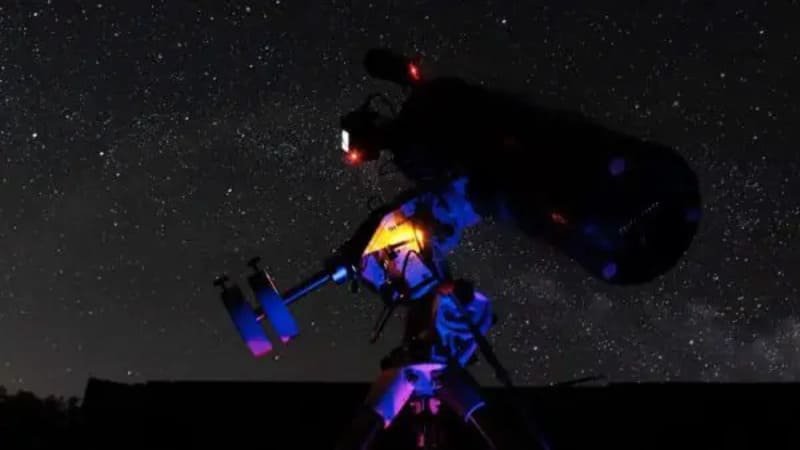
Telescopes
To immerse yourself in the wonders of the Milky Way using a telescope can be rewarding. While there are many options, it depends on your preference and budget. Here are three common types of telescopes you can consider:
- Refractor telescopes
- Reflector telescopes
- Catadioptric telescopes
When observing, assembly and aiming are made easier with a mount. Equatorial mounts help track celestial objects, and alt-azimuth mounts provide simple up-down and left-right movement.
Night Sky
Observing the Milky Way can be magical, but certain factors play their part in getting the best view. To increase your chances, follow these tips:
- Location: Find a place with minimal light pollution. Seek out dark areas away from city lights.
- Time: The Milky Way season runs from February to October. New moon nights provide optimal darkness for observing.
- Weather: Clear skies are ideal for stargazing. Keep an eye on the weather forecast.
Remember to give your eyes time to adjust to the darkness, and be patient when searching the night sky.
FREE STARGAZING CHECKLIST
My 5-page Stargazing Checklist will enhance your astronomical observations.
Follow this free checklist to navigate the night sky with confidence, clarity, and a sense of preparedness for a rewarding stargazing experience.

Ready to dive deeper? Read my article:
Milky Way’s Neighbors

Andromeda Galaxy
The Andromeda Galaxy is our closest large neighboring galaxy, about 2.5 million light-years away. It’s much like our Milky Way, with a vast array of stars, dust, and gas all swirling together in a cosmic dance. When you gaze up at the night sky, think about how Andromeda Galaxy is getting closer to us at a speed of around 110 kilometers per second. Don’t worry, though! The predicted cosmic collision is approximately 4 billion years away.
Local Group
Let’s take a step back and look at the bigger picture. Our Milky Way is part of a collection of over 50 galaxies called the Local Group. It’s like a friendly neighborhood gathering in the vast universe. This group includes several smaller galaxies like the Triangulum Galaxy and the Large Magellanic Cloud. Grab a telescope and try to spot some of our cosmic neighbors on a clear night. Remember, you’re part of a much larger cosmic community!
Key members of the Local Group:
- Milky Way
- Andromeda
- Triangulum
- Large Magellanic Cloud
- Small Magellanic Cloud
Satellite Galaxies
Now, what about those smaller galaxies I mentioned? Well, the Milky Way has its own bunch of little companions called satellite galaxies. They orbit around our galaxy much like moons orbit around a planet. Some well-known satellite galaxies include the Canis Major Dwarf and the Sagittarius Dwarf Spheroidal Galaxy. As an amateur astronomer, you can join the fun in discovering more about our cosmic companions!
The Future of the Milky Way
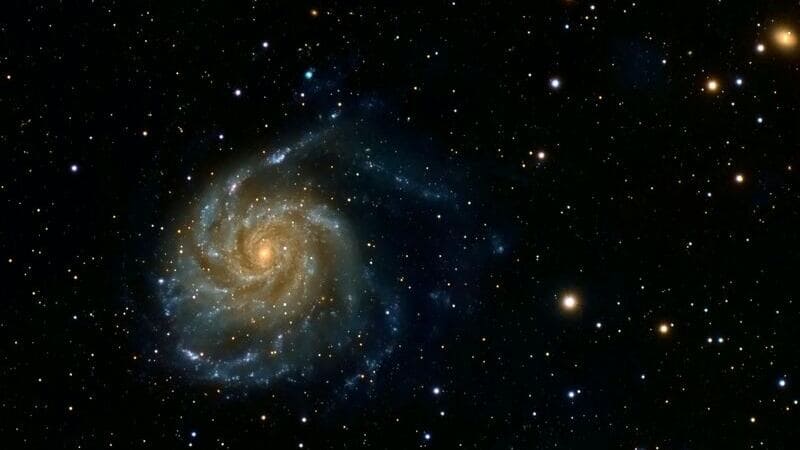
Collision
In about 4 billion years, an enormous event will reshape the Milky Way: our galaxy will collide with the neighboring Andromeda galaxy. You might be worried about what this means for Earth, but don’t panic. Although it’s a massive cosmic event, our solar system will be safe and not destroyed.
During the collision, countless stars and their planets will whirl around, forming new stars. But don’t expect any fireworks! Space is so vast that actual collisions between stars will be scarce. Instead, gravity will tug and stretch both galaxies, intermingling them until they eventually merge.
Pinwheel
As our Milky Way and Andromeda come together, they’ll create a whole new cosmic structure: a pinwheel galaxy. A pinwheel galaxy has beautiful spiral arms that swirl outward like dancers gracefully extending their arms.
So, how do we know this? By observing other galaxies, astronomers have learned much about how these mergers play out. When they see galaxies with some features of both spiral and elliptical shapes, they start to understand how our Milky Way might change over time.
To imagine what our future pinwheel galaxy might look like, picture it like this:
- A stunning central core of bright stars packed tightly together
- Flowing spiral arms reaching outward, where new stars are born
- Majestic swirls of gas and dust provide the ingredients for new celestial objects
As you gaze up at the night sky, ponder the fantastic changes that await our Milky Way in a few billion years. Talk about a cosmic renovation!
Galactic Components
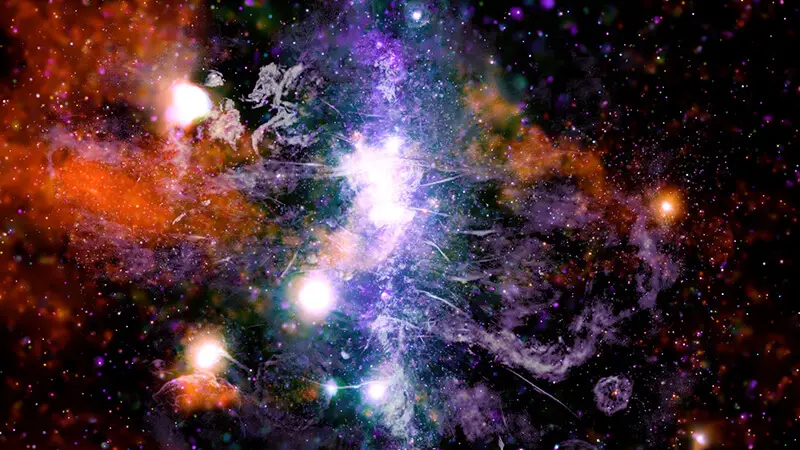
Gas
The Milky Way is filled with gas, forming an essential galaxy part. This gas, called the interstellar medium, creates new stars when it clumps together under gravity. The two main types of gas you’ll find in the galaxy are:
- Atomic gas
- Molecular gas
Think of them like building blocks for stars.
Dust
Besides gas, there’s also a lot of interstellar dust in the Milky Way. This dust comprises tiny particles and plays a crucial role in forming stars and planets. If you’re ever out stargazing and notice that some parts of the sky seem darker than others, you might be looking at patches of interstellar dust blocking starlight.
Here are a few fun facts about interstellar dust:
- It’s not like the dust in your home; it’s more like tiny grains of sand or soot.
- Dust particles can be made of various materials, such as silicates and carbon compounds.
- Interstellar dust helps cool down regions in space by absorbing and radiating heat.
So next time you’re tempted to complain about dust in your house, remember that it plays a vital role in our universe!
Dark Matter
Lastly, let’s talk about dark matter. This mysterious stuff makes up much of the Milky Way’s mass and holds the galaxy together through its gravity. Despite its crucial role, dark matter remains one of astronomical mysteries. Dark matter doesn’t emit, absorb, or reflect light, so we can’t directly see or photograph it. We know it’s there because of its gravitational effects on the visible matter in the galaxy.
Here’s a quick breakdown of what you should know about dark matter:
- It makes up around 85% of the interstellar matter in the universe
- It doesn’t interact with light or ordinary matter
- Its composition is still unknown
Imagine trying to solve a puzzle with invisible pieces! That’s what astronomers are up against when studying dark matter.
Discovery and Exploration of the Milky Way

Jan Oort
One name stands out in the early days of studying the Milky Way: Jan Oort. Oort was a renowned astronomer who contributed significantly to our understanding of the Milky Way. Using his knowledge of radiation and distance, he was able to calculate the approximate size and structure of the galaxy – an incredible feat, considering the technology available at the time.
Oort studied various aspects of the Milky Way, but most importantly, he discovered that our galaxy’s mass is concentrated in a central region. This invisible mass played a crucial role in understanding the dynamics of the Milky Way. For example, it can determine the distance between objects in our galaxy, measured in light-years. One light-year is about 6 trillion miles!
Artist’s Illustration
An artist’s illustration is an essential tool in helping us visualize complex concepts, like the structure of the Milky Way. You don’t have to be a scientist to explore our galaxy, thanks to NASA.
One striking feature of the Milky Way is its spiral structure, not just any spiral, but a structure with two primary arms extending from a central bar of stars. With insights from the Spitzer Space Telescope, we know these two beautiful arms make up the Scutum-Centaurus region.
Here are some tips to help you explore the Milky Way on your own:
- Start by stargazing on a clear, moonless night
- Use binoculars or a telescope to enjoy a closer look
- Observe the sky in different phases of the night to see how it changes
Ready to dive deeper? Read my article:
Milky Way History and Mythology

Greeks
The Milky Way has fascinated people for centuries, especially the ancient Greeks. They believed the hazy band of light in the night sky was a milky circle made from milk. This milk was thought to come from the Greek goddess Hera, who we’ll learn more about later.
Romans
The Romans also had their interpretation of the Milky Way. They translated the Greek term “γαλακτικὸς κύκλος” to Latin as “Via Lactea,” which means milky circle as well. They, too, were captivated by its celestial beauty, and their stories also revolved around milk, as you’ll see below.
Myths
There are various myths surrounding the formation of the Milky Way. In many of these stories, milk is a common theme.
- River of Milk: Some ancient cultures believed that the Milky Way was a river of milk flowing across the sky, a metaphor for life-giving nourishment.
- Goddess Hera: The Greeks believed that the milk came from the breast of the goddess Hera. According to one legend, when Hera’s baby, Heracles, was placed on her breast to feed, some milk spilled across the sky, creating the Milky Way.
River of Milk
The idea of the Milky Way as a river of milk has further roots in mythology. For instance, the constellation Sagittarius is near the center of our galaxy. In Greek mythology, Sagittarius is a centaur, a human and horse creature. Centaurs were known for being wild and untamed. This made Sagittarius the perfect guardian for the mythical river of milk.
Goddess Hera
As mentioned earlier, the Greek mythology behind the Milky Way originates with the goddess Hera. She’s the queen of the gods and the goddess of marriage and childbirth. Hera’s association with milk and nurturing symbolizes her divine role in fostering life.
From the Greeks to Hera herself, the Milky Way has been a source of wonder and intrigue in our cosmic neighborhood. Now that you have a glimpse into the history and mythology of this celestial beauty, why not explore the other galaxies, stars, and celestial wonders that await you in amateur astronomy?
Extrasolar Phenomena
Have you ever wondered about the vast and mysterious cosmos beyond our Solar System? Let’s explore some fascinating extrasolar phenomena taking place in our very own Milky Way Galaxy.
Thousands of planets are orbiting stars outside our Solar System, known as exoplanets. These intriguing worlds can range from rocky, Earth-like worlds to massive gas giants.
One stellar region to peek at is the Orion-Cygnus Arm, a spiral arm in our Milky Way where a wealth of star formation regions can be found. Picture a nursery of young stars in your mind—how cute is that? Among these regions, you’ll find majestic clouds made of dust and gas, giving birth to new stars that light up the cosmic neighborhood.
Now, let’s break down the main categories of extrasolar phenomena you’ll come across:
- Planets: Rocky or gaseous worlds orbiting a star
- Exoplanets: Planets outside our Solar System
- Star-forming regions: Areas in space where stars are born
- Elliptical galaxies: Massive collections of stars shaped like ellipses
- Orion-Cygnus Arm: A spiral arm in the Milky Way with numerous star-forming regions
As you gaze up into the night sky, remember that there’s a whole universe of exciting and wondrous phenomena beyond our Solar System just waiting to be discovered.
Ready to dive deeper? Read my articles:
Frequently Asked Questions
How many solar systems are in the Milky Way?
There are a lot of solar systems in the Milky Way, just like our own, with a centerpiece star and orbiting planets. There are about 100 billion stars in the galaxy, many of which probably have solar systems. So, you can imagine the vastness of our cosmic neighborhood!
What is located at the center of the Milky Way?
At the heart of our galaxy lies a supermassive black hole called Sagittarius A*. Don’t worry. It’s about 26,000 light-years away from Earth, so it won’t suck us in anytime soon. Picture it like a cosmic vacuum cleaner with an appetite for stars and planets.
How many stars exist in the Milky Way?
The Milky Way is like a glittering jewel box filled with around 100 billion stars, give or take a few billion. If you think that’s a lot, remember there are billions of other galaxies in the universe! Space is truly a mind-boggling place.
How many planets can be found in the Milky Way?
With so many stars in our galaxy, you might wonder how many planets there are. Well, astronomers estimate there could be around 40 billion Earth-sized planets orbiting in the habitable zones of Sun-like stars. So, a giant cosmic party is going on, and we’re just one small part of it!
What is the classification of the Milky Way galaxy?
Picture a cosmic pinwheel spinning in space: Our galaxy, the Milky Way. To be more specific, our galaxy is classified as a barred spiral galaxy. This means it has a bright central bar-shaped region surrounded by spiral arms filled with stars, gas, and dust. It’s like an eternal cosmic dance.
Where is Earth situated within the Milky Way?
If you imagine the Milky Way as a sprawling city of stars, Earth is in one of its suburbs. Our solar system is located in the Orion-Cygnus Arm, about 26,000 light-years from the bustling center. So, in cosmic terms, we live in a peaceful, starry neighborhood!
Summary: Milky Way
Thank you for reading my article about the Milky Way. Have you ever looked up at the night sky and wondered about the beautiful band of stars stretching across it? That’s our very own galaxy – the Milky Way!
It might look like a cloud of stardust to the naked eye, but it’s home to billions of stars, including our Sun. The Milky Way is a large barred spiral galaxy, which means it has a central bar-shaped structure made of stars, with spiral arms extending outwards.
In the Milky Way, stars and gases are grouped into areas called “arms.” Some of these arms have more stars than others, giving them a bright appearance. Did you know our Solar System is part of one of these arms? We are in the “Orion Arm.” These arms might look like they are far away, but the truth is we’re living right inside our galaxy!
Now that you’ve learned a bit about our Milky Way galaxy, take time to appreciate its beauty on a clear night. Find a spot far away from city lights, and bring some friends or family members for a fun stargazing experience. Discover more about our fascinating galaxy; remember, we’re just a tiny part of this vast cosmic neighborhood.
Read my other articles in my Milky Way series:
- Can You See the Milky Way with a Half Moon?
- How Many Solar Systems in the Milky Way?
- When is Milky Way Season?
- Why Does the Milky Way Look Cloudy?
- Are all the stars we see in the Milky Way?
- Does the Milky Way orbit anything?
- Are the constellations in the Milky Way?
- How are Milky Way pictures taken?
- Can you see the Milky Way with a full moon?
- Can you see the Milky Way on a cruise?
- Can I See the Milky Way with My Eyes?




